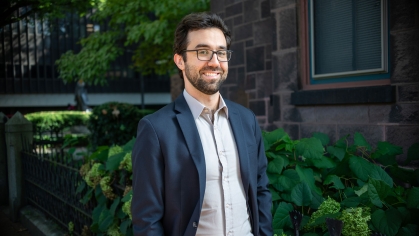Dual Justice: Professor's New Book Explores Contrasting Approaches to Street and Corporate Crime

The new book Dual Justice: America’s Divergent Approaches to Street and Corporate Crime (University of Chicago Press) dives deep into the history of the U.S. legal system to answer a common question: Why are those convicted of street crime viewed and treated differently than white-collar offenders?
The book’s author, Anthony Grasso, assistant professor of political science at Rutgers University–Camden, has made this question one of his primary research focuses since his own graduate studies.
While a student himself, Grasso took a seminar titled “Race and 20th Century American Political Thought”; the course influenced Grasso’s dissertation, and later, his book, on how long-debunked race science and eugenics theories have shaped the development of the nation’s approaches to crime and punishment through the present day.

Dual Justice, Grasso’s first book, traces the historical roots of street and corporate crime disparities to the Progressive Era, which marked the expansion of business and large-scale political and social reforms in the United States. Grasso said that from the late 19th to the early 20th century, leaders were committed to the notion that science should be an anchor for government policy.
Researchers at the time viewed street criminals—typically poor people of color—as biologically defective individuals whose actions justified severe sanctions. One such propagator was Progressive Era scholar G. Frank Lydston, who labeled street crime offenders “incorrigible.” Lydston was further buoyed in his assertions by now-debunked research that claimed criminals’ skulls were irregular compared to the general population.
“Like many in his day, Lydston said that poverty and criminality were inherently related and should be grounds for incarcerating people or even forcibly sterilizing them to prevent the propagation of their genes,” Grasso said. “These were common beliefs among Progressive Era eugenicists.”
In striking contrast, Progressives condoned corporate crimes, framing them not as harmful but as reflective of the perpetrators’ competitive nature. “They were thought to be really ambitious people who were trying to get ahead in the free market,” Grasso said. In an effort not to heavily punish companies, regulatory agencies were established, precursors to the federal institutions that later emerged, like the U.S. Securities and Exchange Commission and the Federal Trade Commission, which continue to monitor bad actors today.
In a bitter irony, the Progressive movement leaned into the hard-hitting science of the time, and though these theories have long been debunked, Grasso argues the ideas behind them still impact inequality in the criminal justice system. He called the 19th century a critical juncture, and his book further explores the two divergent trajectories that emerged in punishing street crime offenders in prison versus corporations through regulatory agencies.
Grasso, who teaches many of the Department of Political Science’s courses related to constitutional law and political theory, offers several suggestions for reform. He suggests applying the regulatory approach to street crime offenders, as regulation could provide measures to prevent crimes from occurring, particularly in poorer communities. He also advocates a “level-up” approach espoused by law scholar James Q. Whitman, who cites success in some European nations that, in an attempt to equalize the system, elevate all offenders up to the most humane punishments rather than hand down the most severe ones, as happens in America’s current “level down” system.
Grasso puts forth a far-reaching call to action for systemic change.
“The problems of crime, and the inequalities the book studies, are best resolved through deep, political and economic reforms rather than the use of criminal law,” he said.


